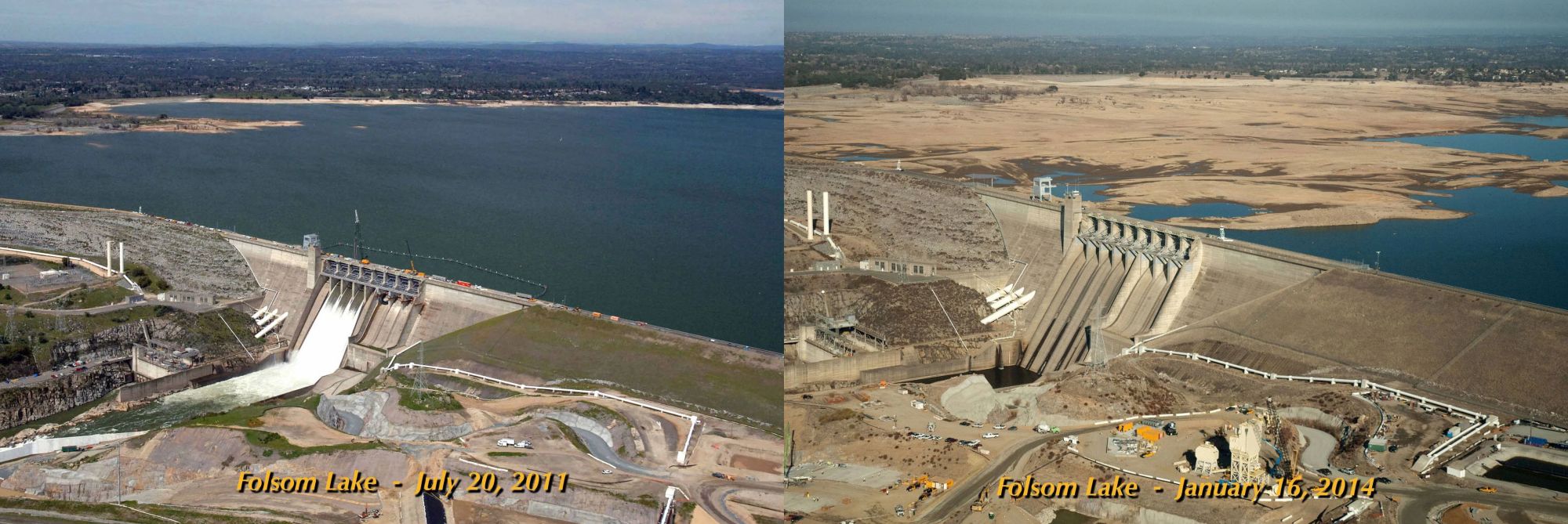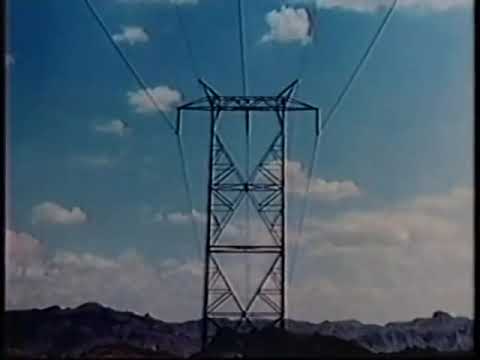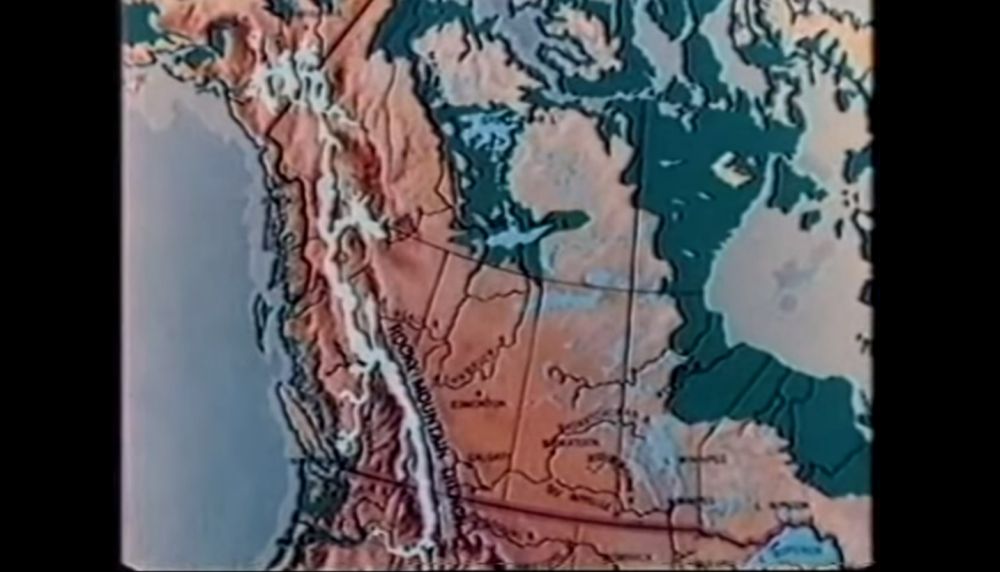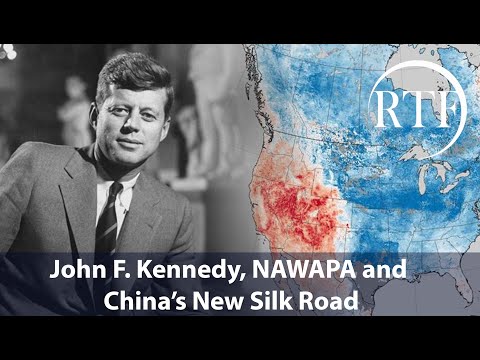Matthew Ehret
Currently, the USA faces a variety of existential crises - some natural and others man-made. In the case of the water crisis which I would like to speak about today, I think we can say that it is a bit of both.
During the Summer of 2020, record breaking fires swept across California and Oregon creating breathing hazards all the way up to British Columbia and wrecking havoc on urban areas and farms. Additionally, NASA's Earth Observatory Drought Monitor has reported that over a third of the USA faces drought, and the UN has reported that over 40% of the USA is at risk of desertification.
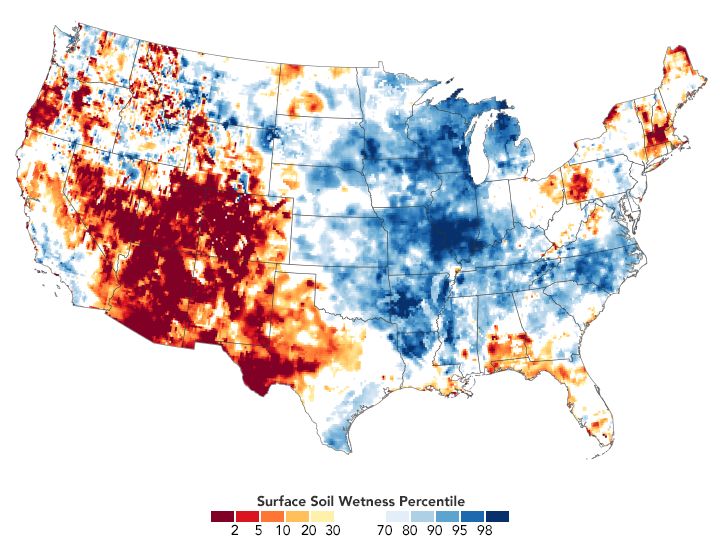
What makes these figures so dire is that the south west coast of the USA is a major producer of agriculture and in a world which faces the worst food crisis in over 50 years ( 8 million people having died of starvation in 2020), such a loss of food production would be more than devastating.
Making matters worse, U.S. farming income has collapsed from $123 billion in 2013 to only $63 billion in 2019 and with the chaos on supply chains caused by COVID restaurant closures, farmers have been forced to dump their produce at record numbers while farming bankruptcies have reached record highs.
Where could the needed water come from?
Underground aquifers which take thousands of years to replenish have historically been a source of water for drought-stricken regions, but as we see with the case of the gigantic Ogallala aquifer providing the High Plains basin which has dropped by 19 feet in only 17 years, such sources are not going to be there forever.
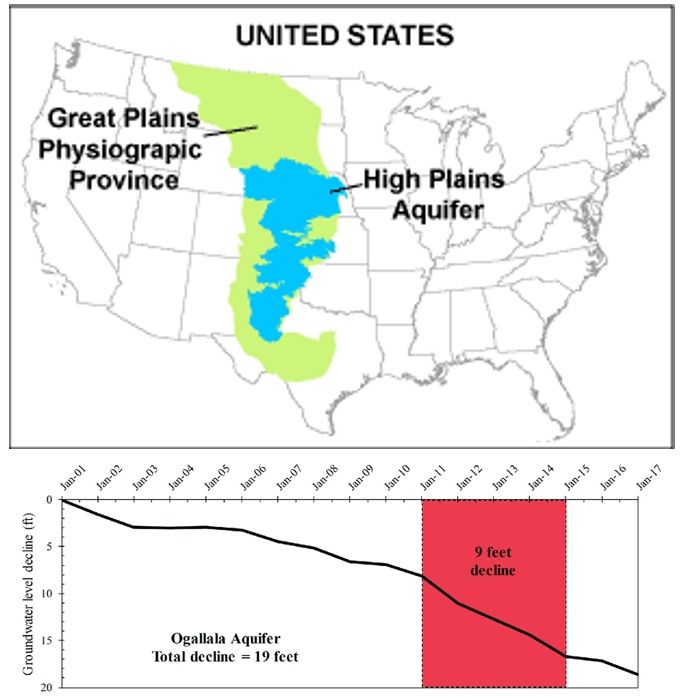
Reservoirs built up during the "age of water projects" from the 1930s-1960s such as the Shasta Lake reservoir, Lake Oroville reservoir or Folsom Lake reservoir have found themselves on the verge of total depletion and the dams themselves which were built 50-90 years ago that not only provided hydroelectric power, but flood controls, and water management systems are decaying requiring billions of dollars in repairs.
Two zero-sum solutions
Unfortunately, solutions to these bleak problems are desperately lacking and neither of the two most popular solutions offer much in the way of long-term practicable remedies as they are both equally trapped in a world of "zero sum" thinking. The first of these two zero sum approaches posits that we can act on the problem by diverting water from one place to another in piecemeal fashion. But in such drought-stricken regions, there is very little abundance to begin with and moving water from one place where the resource is scarce to another place where it is scarcer simply creates more tension and simply kicks the crisis can down the road for a few more months or years.
The other more cynical view states that "it was a mistake to believe that we could have used science and technology to populate the west coast of the USA to begin with over the past 120 years". The adherents of this view look upon the great dams built under Franklin Roosevelt's New Deal which made the Imperial Valley possible as an abomination of nature.
Arial picture of the Imperial Valley in California built up during the days of Franklin Roosevelt
These folks (who include such figures as the former Governor of California Gerry Brown Jr) conclude that humanity should learn from this crisis by adapting to the deserts which nature has created and simply depopulate places like California whose population exceeds that of the whole of Canada by over 7 million souls.

What unites both of these approaches is the adherence to zero sum thinking. This is the belief which assumes that both ecosystems and human economies are 1) closed systems, 2) maintained by finite energy whereby 3) any new energy expended in one part of the system requires that the equivalent amount of energy be removed from another part of the system in question.
Before returning to non-zero-sum solutions which are available for the current American water crisis, let us take a moment to look at another part of the world not limited by this sort of closed system thinking.
The Case of China's Move South Water North Project
It is an undeniable fact that China is currently leading the world in large scale megaprojects.
From the 135-nation strong Belt and Road Initiative, to their alliance with Russia and the Eurasian Economic Union on such projects as the Polar Silk Road, to their support for conditionality-free African, Asian and Latin American infrastructure programs, China has created many new precedents for financing, and economic planning that are infusing strength and confidence in the new Multipolar Alliance in contrast to the unipolar system dominant among western geopoliticians.
Commemorating the 75th Anniversary of the UN Charter, President Xi Jinping said: "Cold War thinking, ideological lines or zero-sum game are no solution to a country's own problem, still less an answer to mankind's common challenges. What we need to do is to replace conflict with dialogue, coercion with consultation and zero-sum with win-win."
One of the most overlooked components of China's anti-zero-sum paradigm which bears directly upon the matter of North America water crisis is a megaproject called the "Move South Water North Project".

Begun in 2001, the $64 billion water diversion project is the largest such program ever divised in human history. In order to bring much needed water from the flood prone, low-population density headwaters of the Yangtze River of the south to the highly populated industrial zones of drought-prone North, engineers have embarked on a project which aims to bring 44.8 billion cubic meters (1.5 trillion cubic feet) of water per year from the south to the North and Yellow River basin.
Divided into three routes, the first to begin construction was the Eastern Route upgrade of the Grand Canal bringing 12.6 billion cubic meters/year of water from the Yangze via massive tunnels to avoid evaporation across 760 miles to Tianjin. This journey will take the water through 23 pumping stations, and provide 45.4 mW of power along the way. This route was completed in 2013.
The next route which was built between 2004-2014 is the Central Route diverting 9.5 billion cubic meters/year of excess water from the Danjiangkou Reservoir on the Han River to Beijing 765 miles away. This immense endeavor features the construction of two tunnels moving this water 65 meters below the Yellow River in its journey north.
Finally the third Western Route will only be completed in 2050 and will bring water from the Yangtze and tributaries to the Yellow River passing through the Tibetan Plateaus.
While detractors of these projects focus only on the 330 000 people who were displaced due to these projects, it is undeniable that the flood controls, increased irrigation, and water availability for urban and industrial activity will save countless lives over the coming centuries.
Returning to North America
So what would this sort of non-zero sum thinking allow us to do in the abysmal case of North America?
If we remove from our minds adherence to the assumption that North American water systems must be defined regionally as closed systems and that planning can only occur using "bottom up" thinking, new vistas open up to us. By starting with an open system view which sees ecosystems and economies as being "more than the sum of their parts" and allowing our minds to problem solve from a top down perspective, then that enlarged context and perspective changes both the parameters of the problem and the available pathways to solve it.
Taking a look at the North American continent as a whole we find many similarities to the problem faced by the Chinese.
North America's water cycle features an immense amount of rain water and unused water runoff in the north where there are few people and little industrial activity while there is very little water in the south where we find high population and agro-industrial activity.
Over 2200 million acre feet/year rains down upon the land in Alaska and the Northeastern continent of Yukon, and BC, 1300 million acre feet/year of that rain runs off directly into the Arctic and north Pacific salt water never to be used in any biospheric process. Compare this immense runoff with the 110 million acre feet/year continental average. This number is 40 times more runoff than what is experience in North Mexico or the Southwest USA.
In the 1960s, continental water management and non-zero-sum thinking were much less taboo than they have become in recent years. Under the short-lived leadership of President John F. Kennedy a new era of large scale water projects was unveiled which reflected this paradigm. Kennedy immediately reversed Eisenhower's "No New Builds" agenda and immediately supported bills to accelerate Federal funding for water/hydro/irrigation projects across the nation.
During an August 17, 1962 dedication ceremony to the Trans Mountain tunnel system connecting Atlantic and Pacific watersheds, Kennedy exemplified this optimistic outlook:
"This is an investment in the future of this country, an investment that will repay large dividends. It is an investment in the growth of the West, in the new cities and industries which this project helps make possible. And I hope that in the 1960s we will commit ourselves to this same kind of mutual effort, and not regard those projects which aid our cities as inimical to Colorado or those projects which help our farmers as taking it away from our cities. Because that concept of the moving ahead of a great country on a great errand is what I think can give this country its leadership in the future as it has in the past."
Kennedy's death derailed many of the projects which he and his close collaborators like Senator Frank Moss and Robert Kennedy were pushing during this period, as a Malthusian anti-development paradigm become infused into national policy making.
One particular project which arose at this time was called the North American Water and Power Alliance (NAWAPA), sponsored by the Parsons company and endorsed by leading politicians from both sides of the aisle including Robert Kennedy. Unbeknownst to many people today, this project became federal legislation by 1965 and won over many leading Canadian and American engineers and statesmen who conducted a battle for several years which ultimately saw the project drift off into obscurity under the fog of the Vietnam war as outlined in the 2012 film NAWAPA 1964.
In Canada, water management projects built up under the leadership of B.C. Premier W.A.C. Bennett set the stage for the NAWAPA project itself which I outlined in a 2012 historical study "W.A.C. Bennett: Canada's Spiritual Father to NAWAPA".
Under the 1964 feasibility studies conducted by the Parsons engineers and displayed in a 15 minute 1964 promotional video , this continental water project would involved the construction of 95 dams, 8 lifts, 39 major tunnels, and 4515 miles (7266 km) of canals in order to collect and move between 10-20% of the fresh water runoff from Northern Alaska and Canada down into the Southwestern USA and North Mexico. Under this design and amplified by studies conducted over the ensuing 50 years, a second circuit would take 19 million acre feet of water/year from the Peace River dam in North BC through the Canadian prairies and into Lake Superior both cleaning out and replenishing the depleted polluted lakes.
A recent rendition of the NAWAPA program created by EIR in 2010 featuring the largest components of the megaproject stretching across Canada and the USA
Part of this second Canadian circuit would serve as a barge canal and provide over 35 GW of hydroelectric power for Canada's use as the nation begins to recover from 45+ years of globalized outsourcing of its manufacturing/industrial base while opening up inroads into the under-developed mid Canada development zone (sometimes known as the Canadian shield) connecting additional lines of rail, roads and new cities together, opening up new corridors of resource development and building connections from Hudson Bay and James Bay into the Great Lakes. Floods which periodically wreck havoc on Alberta and the prairies would also be regulated with new flood control systems.
NAWAPA image from 1964 Parson Co. film featuring northern collection zones
During the collection phase on the Susitna, Copper, Yukon and Taku Rivers, water would be pumped up 300 feet into a reservoir 2400 feet above sea level in the Stikine reservoir. From here 70 million acre feet per year would be pumped into the Rocky Mountain Trench which forms a naturally occurring reservoir 500 miles long and would hold a total capacity of 650 million acre feet, of which 100 million acre feet could be released per year as needed into the parched south.
NAWAPA image from 1964 Parson Co. film featuring U.S. distribution zones
Before making it to the parched south, coming out of the Rocky Mountain trench, the water would be lifted high above sea level via the Sawtooth lifts in Idaho and Oregon, and transiting via canals and tunnels (to avoid evaporation) through Utah, Nevada, California, Arizona, Texas and North Mexico. Along the way farmlands would double from 21 million acres to 44.3 million acres, aquifers like the Ogallala would replenish, desertification would reverse as dry lifeless zones would become rich ecosystems ripe for forestation, agriculture and more.
Describing his philosophy of water development and the role of science and technology as acting harmoniously with the forces of nature, John F Kennedy remarked:
"There are two points on conservation that have come home to me in the last 2 days. One is the necessity for us to protect what we already have, what nature gave to us, and use it well, not to waste water or land, to set aside land and water, recreation, wilderness, and all the rest now so that it will be available to those who come in the future. That is the traditional concept of conservation, and it still has a major part in the national life of the United States. But the other part of conservation is the newer part, and that is to use science and technology to achieve significant breakthroughs as we are doing today, and in that way to conserve the resources which 10 or 20 or 30 years ago may have been wholly unknown."
As the unipolar system continues to rupture under its obsolete logic of zero sum thinking, we who wish to have a future for our children must face some existential choices regarding the type of system we would like to see brought online. Of course, one option is the anti-human 'Great Reset'agenda pushed by Davos creatures like George Soros, Bill Gates, Mark Carney, Mike Bloomberg, Prince Charles and Lord Malloch-Brown et al, the other option involves reviving a forgotten paradigm more worthy of human civilization and natural law.
It is with this reality in mind that I hope that the lessons from America's better years and China's current activation of this non-zero sum paradigm may serve as a guiding inspiration for what is possible if we are committed to a positive future for the coming centuries.
The author delivered a presentation on this subject recently which can be viewed here:
